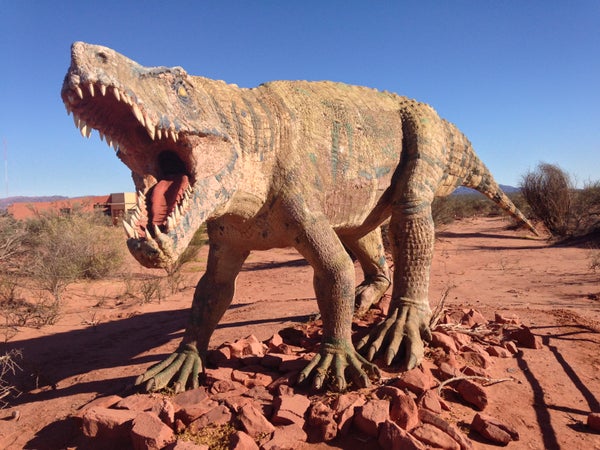This article was published in Scientific American’s former blog network and reflects the views of the author, not necessarily those of Scientific American
Everybody knows about the K/Pg Mass Extinction. As soon as we learn about dinosaurs, and demand to know why we can’t ride to school on a Triceratops, the disappointing fact that an asteroid slammed into the Earth and ended dinosaurian dominance is disclosed. But you may not have heard about the catastrophe that gave dinosaurs their shot at ecological stardom. The terrible lizards were not only cut back by extinction, but they owe their rise to a much earlier disaster. This was the Triassic-Jurassic Mass Extinction.
It can help to focus on our Mesozoic favorites to set the scene. There was a sharp break in life’s record about 200 million years ago. Before that time, in the Triassic, dinosaurs had originated and started to proliferate, but they were mostly marginal creatures. The reptiles running the show on land were more closely related to crocodiles. But in the next chapter, the Jurassic, most of the crocodile cousins had gone and dinosaurs exploded onto the scene. The beginning of the Age of Dinosaurs didn’t start with the group’s origin 235 million years ago, in other words, but after an extinction event that took out the competition about 200 million years ago.
What happened is a mystery. Intense volcanic activity is a likely culprit, devastation caused by eruptions so significant that they altered the world’s climate and acidified the seas. But even with a plausible trigger, we still don’t know why some groups perished while others flourished. This is what paleontologists call “extinction selectivity,” and a new study by Bethany Allen and colleagues investigates the pattern of the survivors and the dead.
On supporting science journalism
If you're enjoying this article, consider supporting our award-winning journalism by subscribing. By purchasing a subscription you are helping to ensure the future of impactful stories about the discoveries and ideas shaping our world today.
While the Triassic saw the origin and diversification of many different animals - including the precursors of mammals - Allen and colleagues focused on the archosauromorphs. This is the broader group to which dinosaurs, crocodiles, and their relatives belong, arguably the most significant group of terrestrial animals during the Mesozoic. (Or at the least the ones we’re most fascinated with.) The question is why some succeeded and others did not. So, to that end, Allen and coauthors investigated how various groups of Triassic archosauromorphs fared and if any of the extinct lineages shared traits in common. Did some subgroups of archosauromorphs survive better than others? Did certain traits held in common - such as body size - make the difference?
What Allen and coauthors found is that, so far as we currently understand, there doesn’t seem to be a single deciding factor in the extinction. Body size didn’t seem to matter among the archosauromoprhs, Allen and coauthors report, nor did there seem to be any other obvious feature the extinct groups had in common. Instead, it appears that certain groups of animals were more vulnerable than others. “Taxa were more likely to become extinct if a close relative also did,” the researchers write, suggesting that there might be some shared feature that made particular groups more likely to disappear. The question is what those traits might be.
Considerations of size, diet, posture, habitat, and where the animals lived on the planet didn’t seem to show any pattern. Answers are still elusive, and the factors that contributed to extinction vulnerability likely varied from group to group and could have to do with facets of ancient life as-yet-undetected. Not to mention that the fossil record is incomplete, as is our knowledge of it, and the critical pieces are obscured from view. But science is a process, after all, and each new investigation has the potential to raise new questions and direct inquiring minds towards ways of answering those queries. Knowing where to look, perhaps those crucial differences can eventually be teased out and what allowed for the rise of the dinosaurs can stomp into view.
